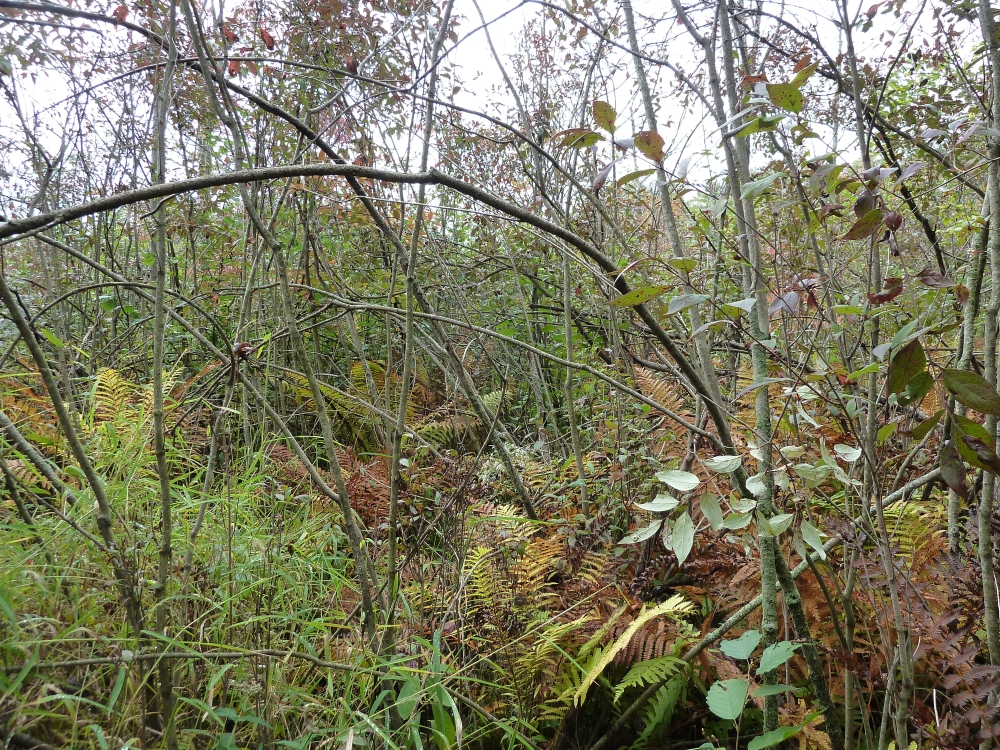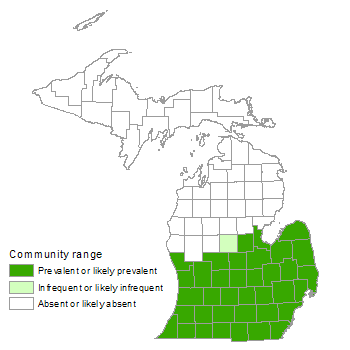Southern Shrub-carr
Overview
Southern shrub-carr is a moderate to long persistent successional shrub community dominated by willows (Salix spp.), dogwoods (i.e., Cornus sericea, C. foemina, and C. amomum), winterberry (Ilex verticillata), and bog birch (Betula pumila). This community is successionally intermediate among a variety of open, herbaceous wetlands (i.e., southern wet meadow, prairie fen, wet-mesic prairie, and lakeplain wet-mesic prairie) and forested wetlands such as rich tamarack swamp and southern hardwood swamp. It typically occurs on saturated, organic soil and is characterized by fluctuating water levels and poor drainage conditions. Southern shrub-carr is found primarily south of the climatic tension zone in southern Lower Michigan and is frequent in other Midwestern states such as Illinois, Indiana, Iowa, Minnesota, and Wisconsin. North of the climatic tension zone, wet-ground, tall shrub communities are typically dominated by tag alder (Alnus incana) and are classified as northern shrub thicket.
Rank
Global Rank: GU - Unrankable
State Rank: S4 - Apparently secure

Landscape Context
Shrub-carr typically occurs as bands along streams, rivers, and lakes, on glacial lakeplains and outwash plains, and within outwash channels and depressions on ice-contact topography and moraines. Sites are characterized by little to no slope and can range from small pockets or narrow bands to extensive acreages. The community often occurs as part of a large wetland complex, where it may form a transition zone between open herbaceous wetlands and forested wetlands.
Soils
Shrub-carr is usually found on seasonally inundated, saturated organic soils such as sapric peat with neutral to mildly alkaline pH and the capacity to retain excessive water.
Natural Processes
Shrub-carr typically originates when shrub species invade fens, sedge meadows, wet prairies, and prairie fens following an alteration to the fire or hydrologic regime. Fire suppression and events that lower local or regional water tables allow shrubs to colonize open wetlands and assume dominance. Conversely, beaver-induced flooding limits shrub and tree encroachment and maintains open conditions of meadows and fens. The extent of southern shrub-carr in Michigan has greatly expanded since European settlement due to widespread fire suppression, hydrologic alterations, and a dramatic decline in the beaver population.
Once shrub-carr has become established, frequent disturbance allows it to persist rather than succeed to a forested swamp community. Beaver herbivory and windthrow can limit tree longevity and help maintain southern shrub-carr. Given that shrub-carr occurs along streams, rivers, and lake edges, the community is well adapted to seasonal hydrologic cycling. However, prolonged flooding can kill shrubs and cause conversion to shallow ponds, emergent marsh, southern wet meadow, prairie fen, or wet prairie depending on landscape position, soils, and depth and duration of flooding. In the absence of flooding and fire, southern shrub-carr typically succeeds to closed-canopy swamp forest, such as southern hardwood swamp and rich tamarack swamp.
Vegetation
There are commonly three distinct vegetation layers in a southern shrub-carr community. The most pronounced is the shrub layer, which typically exhibits little stratification or layering, and ranges in height from 1.5 to 5.5 m (5 to 18 ft, average 2.6 m or 8.6 ft). Common species in the shrub layer may include dogwoods (C. amomum, Cornus foemina, and C. sericea), willows (Salix bebbiana, S. discolor, S. exigua, S. petiolaris, S. serissima, and S. eriocephala), winterberry (Ilex verticillata), elderberry (Sambucus canadensis), swamp rose (Rosa palustris), poison sumac (Toxicodendron vernix), smooth highbush blueberry (Vaccinium corymbosum), American hazelnut (Corylus americana), black chokeberry (Aronia prunifolia), and nannyberry (Viburnum lentago). The shrub layer can be dense to patchy depending on the successional state and local site conditions within the community. The second vegetation layer is an intermediate layer of tall herbaceous plants and short shrubs and can include sedges (Carex stricta, C. comosa, C. hystericina, and C. lacustris), water plantain (Alisma subcordatum), swamp milkweed (Asclepias incarnata), bluejoint grass (Calamagrostis canadensis), water hemlock (Cicuta maculata), water horsetail (Equisetum fluviatile), marsh fleabane (Erigeron philadelphicus), common boneset (Eupatorium perfoliatum), rattlesnake grass (Glyceria canadensis), softstem bulrush (Schoenoplectus tabernaemontani), bulrush (Scirpus pendulus), Canada goldenrod (Solidago canadensis), marsh fern (Thelypteris palustris), bog birch (Betula pumila), swamp gooseberry (Ribes hirtellum), meadowsweet (Spiraea alba), raspberries (Rubus spp.), and shrubby cinquefoil (Dasiphora fruticosa). A third vegetative layer of smaller herbaceous plants may also occur and include species such as bedstraws (Galium spp.), clearweed (Pilea pumila), northern bugle weed (Lycopus uniflorus), Canada mayflower (Maianthemum canadense), and marsh bellflower (Campanula aparinoides). Overall, the vegetation of shrub-carrs is highly variable due to frequent disturbances and small-scale temporal and spatial differences in microtopography, soil moisture, and nutrient availability.
For information about plant species, visit the Michigan Flora website.
Plant Lists
Graminoids
- blue-joint (Calamagrostis canadensis)
- sedges (Carex comosa, C. hystericina, C. lacustris, C. leptalea, C. stricta, and others)
- rattlesnake grass (Glyceria canadensis)
- fowl manna grass (Glyceria striata)
- cut grass (Leersia oryzoides)
- fowl meadow grass (Poa palustris)
- softstem bulrush (Schoenoplectus tabernaemontani)
- bulrush (Scirpus pendulus)
Forbs
- water plantain (Alisma subcordatum)
- Canada anemone (Anemone canadensis)
- thimbleweed (Anemone virginiana)
- swamp milkweed (Asclepias incarnata)
- marsh-marigold (Caltha palustris)
- hedge bindweed (Calystegia sepium)
- marsh bellflower (Campanula aparinoides)
- water hemlock (Cicuta maculata)
- willow-herbs (Epilobium spp.)
- marsh fleabane (Erigeron philadelphicus)
- common boneset (Eupatorium perfoliatum)
- joe-pye-weed (Eutrochium maculatum)
- bedstraws (Galium asprellum, G. boreale, G. triflorum, and others)
- purple avens (Geum rivale)
- great blue lobelia (Lobelia siphilitica)
- northern bugle weed (Lycopus uniflorus)
- golden ragwort (Packera aurea)
- clearweed (Pilea pumila)
- great water dock (Rumex orbiculatus)
- common skullcap (Scutellaria galericulata)
- mad-dog skullcap (Scutellaria lateriflora)
- Canada goldenrod (Solidago canadensis)
- swamp goldenrod (Solidago patula)
- rough goldenrod (Solidago rugosa)
- skunk-cabbage (Symplocarpus foetidus)
Ferns
- marsh fern (Thelypteris palustris)
Fern Allies
- water horsetail (Equisetum fluviatile)
Shrubs
- black chokeberry (Aronia prunifolia)
- bog birch (Betula pumila)
- buttonbush (Cephalanthus occidentalis)
- silky dogwood (Cornus amomum)
- gray dogwood (Cornus foemina)
- red-osier dogwood (Cornus sericea)
- American hazelnut (Corylus americana)
- shrubby cinquefoil (Dasiphora fruticosa)
- winterberry (Ilex verticillata)
- swamp gooseberry (Ribes hirtellum)
- swamp rose (Rosa palustris)
- dwarf raspberry (Rubus pubescens)
- wild red raspberry (Rubus strigosus)
- Bebb’s willow (Salix bebbiana)
- pussy willow (Salix discolor)
- willow (Salix eriocephala)
- sandbar willow (Salix exigua)
- slender willow (Salix petiolaris)
- autumn willow (Salix serissima)
- elderberry (Sambucus canadensis)
- meadowsweet (Spiraea alba)
- poison sumac (Toxicodendron vernix)
- smooth highbush blueberry (Vaccinium corymbosum)
- nannyberry (Viburnum lentago)
Trees
- red maple (Acer rubrum)
- black ash (Fraxinus nigra)
- green ash (Fraxinus pennsylvanica)
- tamarack (Larix laricina)
- American elm (Ulmus americana)
Noteworthy Animals
Because many of the prevalent shrubs produce fruit in late summer, shrub-carr provides important foraging habitat for migrating and over-wintering songbirds. The community provides nesting habitat for the common yellow throat. Ruffed grouse and American woodcock also utilize the community. Large ant mounds, particularly those built by members of the genus Formica, have been observed in shrub-carr and indicate that a site was formerly an open herbaceous wetland prior to shrub colonization.
Rare Plants
- Hypericum sphaerocarpum (round-fruited St. John’s-wort, state threatened)
- Lygodium palmatum (climbing fern, state endangered)
- Pycnanthemum muticum (broad-leaved mountain mint, state threatened)
Rare Animals
- Acris crepitans blanchardi (Blanchard’s cricket frog, state special concern)
- Catocala illecta (magdalen underwing, state special concern)
- Clemmys guttata (spotted turtle, state threatened)
- Erynnis p. persius (Persius duskywing, state threatened)
- Gomphus quadricolor (rapids clubtail, state special concern)
- Hemileuca maia (barrens buckmoth, state special concern)
- Lanius ludovicianus migrans (migrant loggerhead shrike, state endangered)
- Neonympha m. mitchellii (Mitchell’s satyr, federal/state endangered)
- Nycticorax nycticorax (black-crowned night-heron, state special concern)
- Papaipema speciosissima (regal fern borer, state special concern)
- Sistrurus c. catenatus (eastern massasauga, federal candidate species and state special concern)
- Terrapene c. carolina (eastern box turtle, state special concern)
- Williamsonia fletcheri (ebony boghaunter, state special concern)
Biodiversity Management Considerations
Southern shrub-carr is a widespread community type in the Great Lakes region and likely occupies a greater percentage of wetland acreage today than it did in the 1800s due to fire suppression and alterations to hydrologic regimes. The community contributes significantly to the overall biodiversity of southern Michigan by providing habitat to a wide variety of plant and animal species including several rare species. However, southern shrub-carr has replaced many rare and declining wetland communities such as prairie fen, southern wet meadow, and rich tamarack swamp. Where shrub encroachment threatens to convert less common open wetlands to shrub-dominated systems, prolonged flooding, repeated prescribed fires, mowing, or herbicide application to cut shrub stumps can be employed to maintain open conditions. On sites that are succeeding to swamp forest, allowing succession to proceed unhindered will favor an increase of less common swamp systems. Southern shrub-carr can be maintained by cutting tree species. While southern shrub-carr has replace many declining and rare communities, it does provide important ecosystem services, protecting water quality by assimilating nutrients, trapping sediment, and retaining storm water and floodwater.
Invasive species that threaten to reduce the diversity and alter the community structure of southern shrub-carr include glossy buckthorn (Frangula alnus), common buckthorn (Rhamnus cathartica), multiflora rose (Rosa multiflora), purple loosestrife (Lythrum salicaria), narrow-leaved cat-tail (Typha angustifolia), hybrid cat-tail (Typha xglauca), reed (Phragmites australis subsp. australis), and reed canary grass (Phalaris arundinacea). Monitoring for these and other invasive species followed by prompt and sustained control efforts will help protect the ecological integrity of southern shrub-carr and adjacent natural communities.
Variation
Community size, shape, and species composition can vary significantly, depending on landscape context. Generally, occurrences on poorly drained, level outwash plains and lakeplains are larger than those associated with narrow outwash channels and stream corridors.
Similar Natural Communities
Prairie fen, southern wet meadow, northern shrub thicket, inundated shrub swamp, southern hardwood swamp, and rich tamarack swamp.
Places to Visit
- Chamberlain Lakes, Bald Mountain State Recreation Area, Oakland Co.
- Williams Lake, Yankee Springs State Recreation Area, Barry Co.
Relevant Literature
- Bingham, M.T. 1945. The flora of Oakland Co., Michigan. Cranbrook Institute of Science, Bulletin 22. 155 pp.
- Curtis, J.T. 1959. The vegetation of Wisconsin. University of Wisconsin Press, Madison, WI. 657 pp.
- Eggers, S.D., and D.M. Reed. 1997. Wetland plants and plant communities of Minnesota and Wisconsin. U.S. Army Corps of Engineers, St. Paul, MN. 263 pp.
- White, K.L. 1965. Shrub-carrs of southeastern Wisconsin. Ecology 46(3): 286-304.
Citation
Cohen, J.G., M.A. Kost, B.S. Slaughter, D.A. Albert, J.M. Lincoln, A.P. Kortenhoven, C.M. Wilton, H.D. Enander, and K.M. Korroch. 2020. Michigan Natural Community Classification [web application]. Michigan Natural Features Inventory, Michigan State University Extension, Lansing, Michigan. Available https://mnfi.anr.msu.edu/communities/classification. (Accessed: April 19, 2024).
Kost, M.A., D.A. Albert, J.G. Cohen, B.S. Slaughter, R.K. Schillo, C.R. Weber, and K.A. Chapman. 2007. Natural Communities of Michigan: Classification and Description. Michigan Natural Features Inventory, Report No. 2007-21, Lansing, MI.


